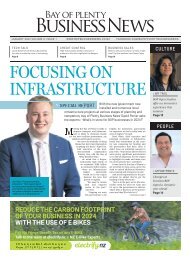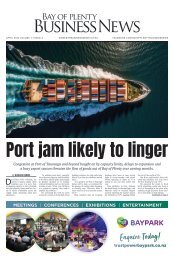April 2024 - Bay of Plenty Business News
From mid-2016 Bay of Plenty businesses have a new voice, Bay of Plenty Business News. This publication reflects the region’s growth and importance as part of the wider central North Island economy.
From mid-2016 Bay of Plenty businesses have a new voice, Bay of Plenty Business News. This publication reflects the region’s growth and importance as part of the wider central North Island economy.
You also want an ePaper? Increase the reach of your titles
YUMPU automatically turns print PDFs into web optimized ePapers that Google loves.
10 BAY OF PLENTY BUSINESS NEWS <strong>April</strong> <strong>2024</strong><br />
> BEYOND SURVIVAL:<br />
Elevating business continuity practices<br />
<strong>Business</strong> continuity is the<br />
ability <strong>of</strong> a business to<br />
continue operating critical<br />
business functions during and<br />
after a disaster event. The goal <strong>of</strong><br />
having a <strong>Business</strong> Continuity Plan<br />
(BCP) is to ensure that a business<br />
can maintain critical functions<br />
and recover quickly from various<br />
disasters. Or at worst, minimise<br />
downtime while services are<br />
restored. This concept is not new,<br />
and we have touched on it in previous<br />
articles.<br />
Some <strong>of</strong> the events that can<br />
cause a BCP to be enacted are<br />
natural disasters (floods, earthquakes),<br />
technological disasters<br />
(cyberattacks, hardware failure),<br />
man-made disasters (industrial<br />
accidents, civil infrastructure<br />
failures), and health emergencies<br />
(global pandemic, critical health<br />
and safety incidents).<br />
Many disasters are out <strong>of</strong> your<br />
control to mitigate. What you can<br />
do is to implement measures to<br />
protect your business from the<br />
fallout <strong>of</strong> these events.<br />
The initial safeguard you can<br />
implement is systems redundancy.<br />
If you have duplicate systems<br />
already in place when the<br />
primary system fails, they will<br />
take over and ensure your business<br />
operations continue. This is<br />
not recovery but continuity – and<br />
that is best.<br />
The next is backups. We all<br />
know that backups are important,<br />
but maintaining effective<br />
backup procedures is critical for<br />
recovering from a disaster. While<br />
this may not provide the continuity<br />
that redundancy does, it is<br />
<strong>of</strong>ten much cheaper and easier to<br />
maintain.<br />
Ideally, you should implement<br />
a 3-2-1 backup strategy: 3 copies <strong>of</strong><br />
the data (original device, external<br />
hard drive, cloud storage), stored<br />
on 2 different types <strong>of</strong> storage<br />
(physical and cloud), in at least 1<br />
<strong>of</strong>fsite location (cloud) in addition<br />
to the onsite copies. These backups<br />
must also be tested regularly<br />
to ensure that they are usable.<br />
An excellent eventuality to<br />
TECH TALK<br />
BY EZRA RENTOUL<br />
prepare for is ensuring your staff<br />
can work from alternative locations<br />
where viable, such as working<br />
from home. This will ensure<br />
that your business can continue<br />
to operate at least to some extent,<br />
while the primary business location<br />
is made available again.<br />
Many businesses have already<br />
experienced this requirement<br />
during the lockdown periods.<br />
The last resort is insurance.<br />
It is the oldest, most commonly<br />
used, and best understood<br />
disaster recovery measure. If<br />
worst comes to worst, you will<br />
at least have financial support<br />
to recover and restore business<br />
functionality.<br />
Having redundant measures<br />
or backup strategies is all well<br />
and good, but if nobody knows<br />
how to apply these strategies, the<br />
effort has been wasted.<br />
Ensuring the right people are<br />
regularly trained in how to implement<br />
both the redundant and<br />
backup measures is critical. You<br />
must also ensure these measures<br />
are regularly tested to ensure<br />
they are operating as intended,<br />
else you may find them non-functional<br />
when you need them most.<br />
Having a written and agreed<br />
upon course <strong>of</strong> action will allow<br />
you and your staff to respond<br />
rapidly to these disasters as and<br />
when they occur. These written<br />
plans are known as <strong>Business</strong> Continuity<br />
Plans (BCP) and Disaster<br />
Recovery Plans (DRP).<br />
The best way to ensure BCP<br />
plans remain precautionary measures,<br />
is by integrating some <strong>of</strong><br />
the following:<br />
• Regular risk assessments<br />
allow you to apply risk mitigation<br />
strategies and prevent<br />
some disasters before they<br />
even occur;<br />
• Training and awareness programs<br />
help your staff to better<br />
protect your business by being<br />
more vigilant in their daily<br />
tasks;<br />
• Cross-training and succession<br />
planning are also crucial in<br />
allowing critical roles to be<br />
filled by multiple people as<br />
required, if the primary person<br />
is unavailable.<br />
Creating and implementing<br />
solid <strong>Business</strong> Continuity and<br />
Disaster Recovery plans ensures<br />
your business will not only survive,<br />
but possibly even thrive<br />
through any disaster.<br />
Ezra Rentoul is a Technical Engineer<br />
at Stratus Blue. He can be contacted<br />
at assist@stratusblue.co.nz<br />
The role <strong>of</strong> debt in funding<br />
community infrastructure<br />
There has been much discussion in recent months about the debt issues the local government sector is experiencing and<br />
the need to find new ways <strong>of</strong> funding vital community infrastructure, particularly in fast-growth centres like Tauranga.<br />
> By ANNE TOLLEY, TAURANGA COMMISSION CHAIR<br />
The need for investment<br />
is driven by community<br />
growth (Tauranga’s population<br />
has grown by around<br />
30% in the last 10 years); having<br />
to catch-up on an underinvestment<br />
in infrastructure over<br />
the last decade and beyond;<br />
AND to provide for future<br />
growth in the face <strong>of</strong> significant<br />
increases in construction costs,<br />
with the price <strong>of</strong> many infrastructure<br />
project components increasing<br />
20% or more in the last couple<br />
<strong>of</strong> years alone.<br />
As a result, councils like ours<br />
are having to take on more debt<br />
to build the new infrastructure<br />
needed to cater for their growing<br />
populations and renew existing,<br />
aging infrastructure, such as the<br />
water, wastewater and stormwater<br />
systems we must have, and<br />
the roads we get around on.<br />
Here it’s worth noting Standard<br />
and Poors’ February commentary<br />
that local government<br />
debt in New Zealand is “very high<br />
on a global scale and is rising<br />
more than our previous expectations”.<br />
One <strong>of</strong> the key reasons<br />
for that is that there is a greater<br />
reliance on local government<br />
here to deliver and<br />
fund infrastructure,<br />
compared to other<br />
countries.<br />
So what’s the solution?<br />
It’s a complex mix <strong>of</strong> prudent,<br />
but timely investment; managing<br />
costs; balancing rates, fees<br />
and charges; selling some assets<br />
to invest in new assets for the city;<br />
and leveraging debt as a significant<br />
component <strong>of</strong> local government<br />
infrastructure financing.<br />
That’s because debt allows councils<br />
to spread the financing cost<br />
<strong>of</strong> community assets over 20-plus<br />
years, which helps make them<br />
affordable. Just as importantly, it<br />
means repayments are funded in<br />
an intergenerational way by the<br />
people who are using and benefitting<br />
from those assets, not just<br />
those who were ratepayers when<br />
the asset was constructed.<br />
Most infrastructure assets<br />
have lifespans ranging between<br />
30 and 100 years, so debt allows<br />
the financing period to be more<br />
aligned with the period the assets<br />
will be in use for.<br />
Debt needs to be serviced by<br />
appropriate revenue streams<br />
and the way that revenue is gathered<br />
also needs to be equitable.<br />
TCC goes to significant lengths<br />
to ensure that, as far as possible,<br />
‘growth pays for growth’, through<br />
development contributions, and<br />
we also work hard to identify and<br />
access any available external contributions,<br />
such as Government<br />
grants.<br />
And <strong>of</strong> course, debt has to be<br />
‘prudent’, both for the council<br />
and for those whose rates and<br />
other contributions (like parking<br />
charges, for example) are<br />
needed to fund debt repayments.<br />
TCC’s primary lender is the Local<br />
Government Funding Agency<br />
(LGFA), which is jointly owned by<br />
all <strong>of</strong> the councils which borrow<br />
through it. The prudent debt limit<br />
applied by the LGFA for TCC’s<br />
total borrowing (in the <strong>2024</strong>/25<br />
financial year) is that debt cannot<br />
be more than 2.9 times our<br />
revenue (reducing to 2.8 times in<br />
future years). Our expected debt<br />
for <strong>2024</strong>/25 will be well within<br />
that limit, but with a number <strong>of</strong><br />
large and costly infrastructure<br />
projects on the horizon over the<br />
coming years, the council will be<br />
closely managing debt and revenue<br />
to ensure these streams are<br />
aligned and that debt funding<br />
remains affordable. One <strong>of</strong> our<br />
key actions we will be investigating<br />
a future structure for three<br />
waters service delivery which<br />
will maintain ratepayer ownership,<br />
but allow the debt related to<br />
water, wastewater and stormwater<br />
infrastructure to be held <strong>of</strong>f<br />
the Council’s balance sheet.<br />
So in summary, debt is needed<br />
to allow essential infrastructure<br />
investment; increased debt can<br />
raise affordability concerns; but<br />
not increasing debt will also have<br />
negative economic and social<br />
impacts.<br />
As commissioner Stephen Selwood<br />
says, the bottom line is that<br />
the community pays either way.<br />
“It’s a choice between raising debt<br />
to fund needed investment, while<br />
working within prudent debt levels<br />
and considering the impact <strong>of</strong><br />
borrowing on rates affordability,<br />
or deferring investment and<br />
suffering lost productivity and<br />
increased costs through inflation,<br />
congestion, rising house prices<br />
and a lack <strong>of</strong> the amenities a<br />
growing city needs.”<br />
Which says that while it’s a<br />
complicated equation, debt is not<br />
a dirty word – it’s a necessity <strong>of</strong><br />
sensible local government.
















